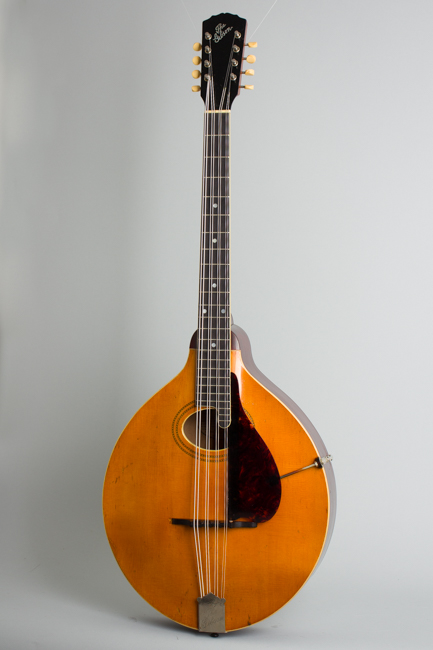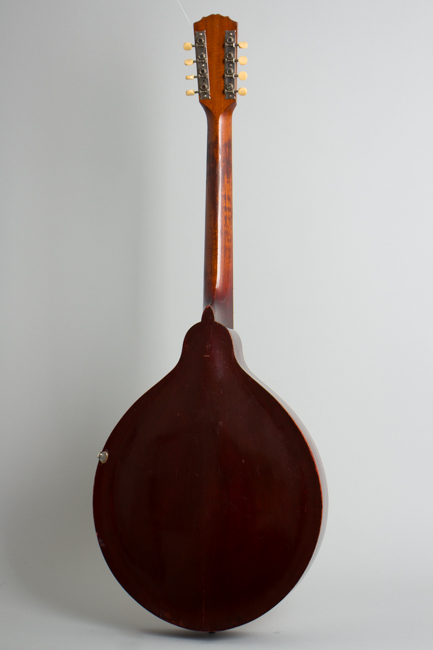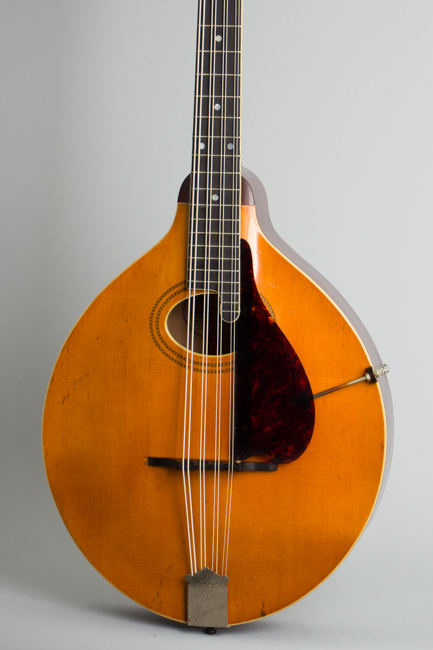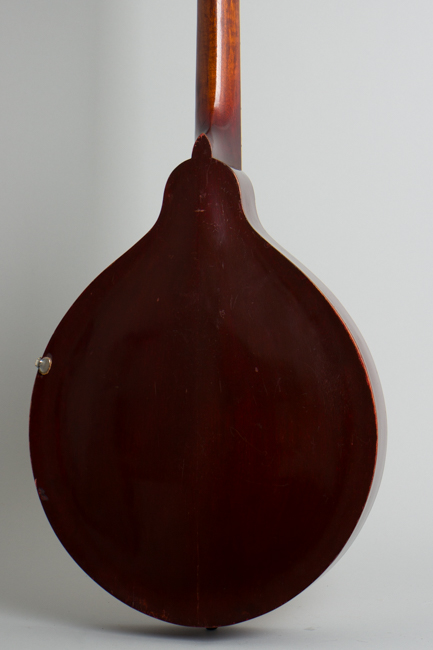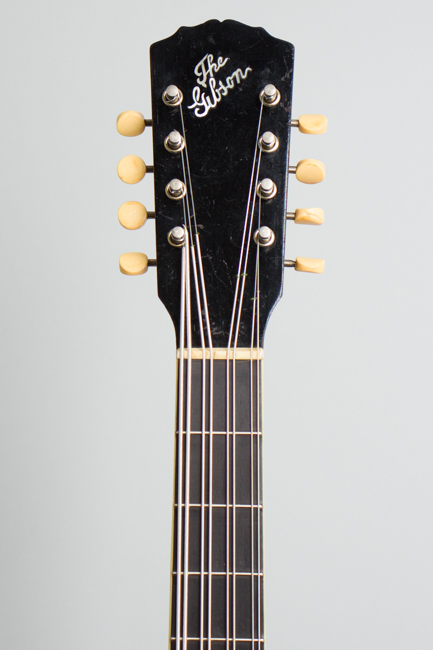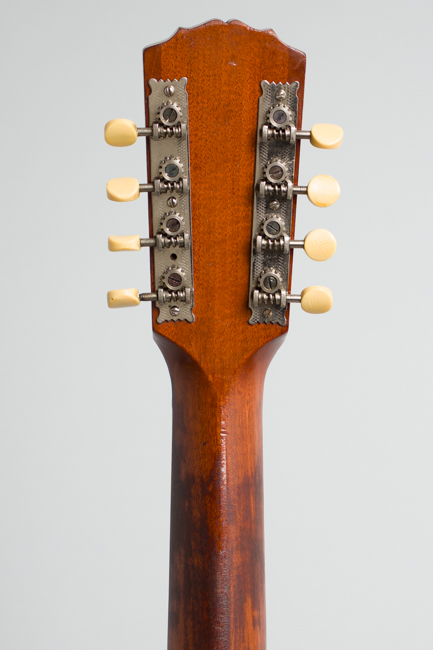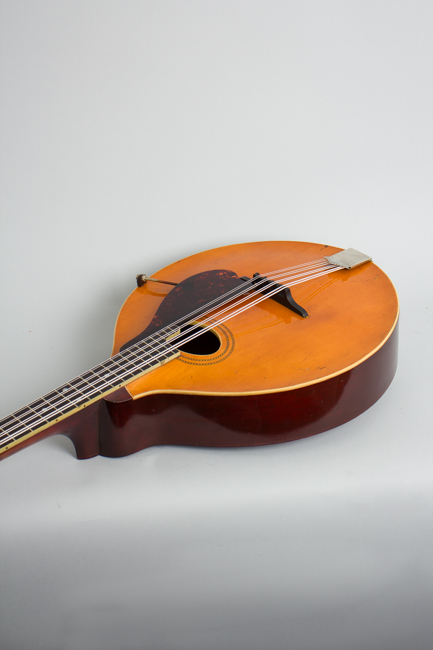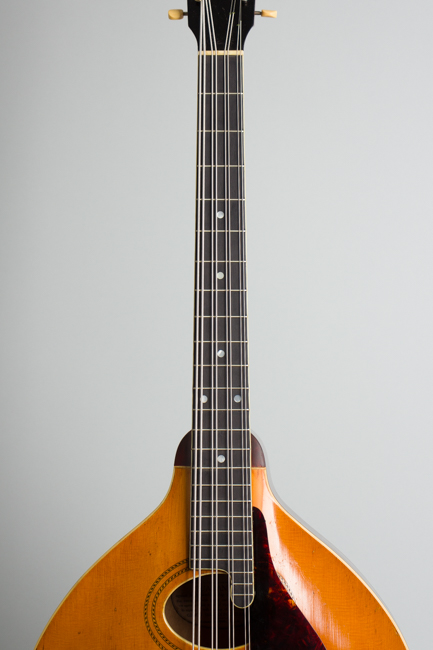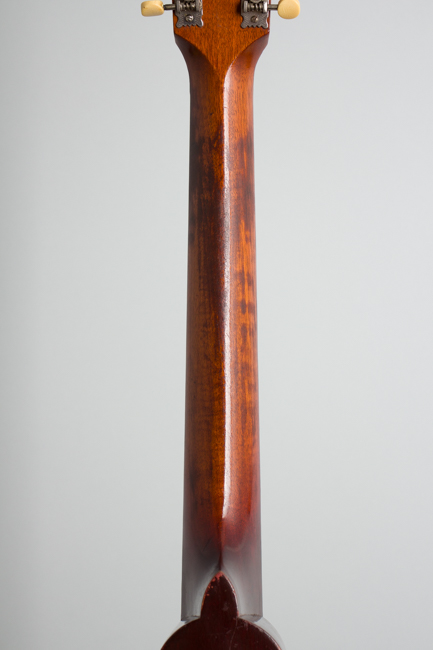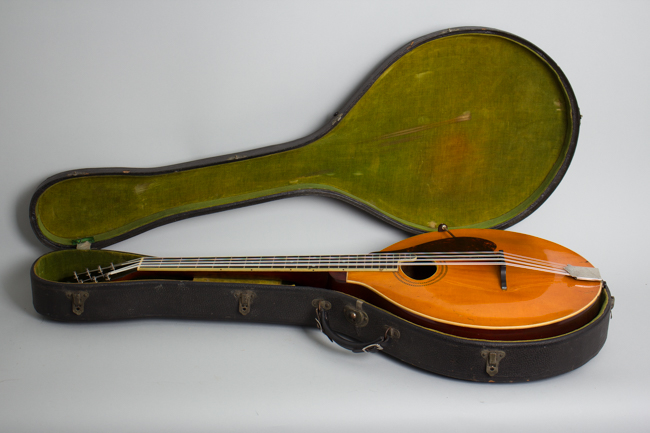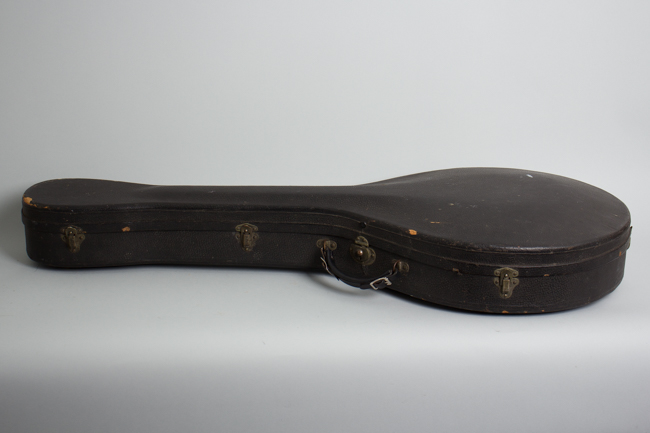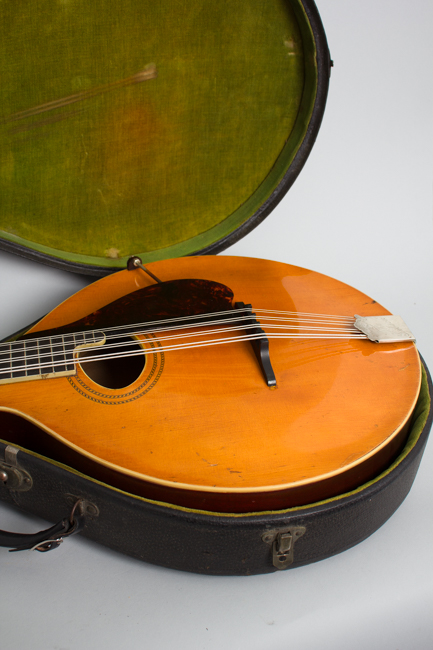Gibson K-1 Carved Top Mandocello (1918)
This item has been sold.
Item # 12237
Prices subject to change without notice.
Gibson K-1 Model Carved Top Mandocello (1918), made in Kalamazoo, Michigan, serial # 47581, natural top, cherry stained back and sides finish, birch back and sides, spruce top; mahogany neck with ebony fingerboard, original black hard shell case.
We feel the Gibson Mandocello is one of the great under-appreciated instruments of the early 20th century. Originally designed for use in 1910s-era mandolin orchestras, these imposing beasts never found a home in any other style of music despite being wonderful and unique-sounding creations. Double-strung and tuned in fifths starting with the C below the low E on the guitar, the mandocello has an imposing tone and deep resonance quite unlike any other fretted instrument. OK, we're starting to sound like an old Gibson catalog here, but we really like these and are always happy to get one in stock!
This particular instrument is a lovely sounding Style K-1, the most basic of the three mandocello models Gibson offered in the 1910s but still a fairly expensive instrument when new. It is structurally the same as the fancier Model K-2 with a little less "geegaw" (decoration). The headstock face carries just a plain pearl "The Gibson" inlay while the openback strip tuners are tipped with unadorned ivoroid buttons.
The sound hole decoration is made up of two separate half-herringbone wood inlaid rings and a bound edge. The K-2 had fancier versions of these decorative touches, but the physical features (and sound) were the same for both, with an oval body, bound carved spruce top with a flat oval soundhole and birch back. The necks on all models are mahogany with a bound and dot-inlaid ebony fingerboard.
This 1918 "Pumpkin top" K-1 Mandocello dates to the decade when Gibson was defining the market for these mandolin family instruments. In the 1910s-'20s Gibsons were only available from licensed teacher-agents, and were usually purchased on a time payment plan along with lessons. As part of the deal, the students would often play in the teacher's fretted orchestra, and the low-tuned mandocello was crucial to achieving a full sound in these ensembles. Far fewer were sold compared to mandolins, however, making Gibson mandocellos from any era a comparative rarity.
With its 8 strings and "C" orchestral tuning the mandocello has a totally unique sound and makes an excellent recording instrument. While mandolin orchestras are rather thin on the ground in the 21st century these instruments can be employed for a wide range of playing styles, some still yet to be explored!
Overall length is 38 7/16 in. (97.6 cm.), 14 1/8 in. (35.9 cm.) width, and 3 3/8 in. (8.6 cm.) in depth, measured at side of rim. Scale length is 24 5/8 in. (625 mm.). Width of nut is 1 5/8 in. (41 mm.).
This well-over-105 year old K-1 shows some general wear and minor repair; it is not the cleanest but one of the nicer sounding ones we have had. The original varnish finish has less micro-checking than some, with a collection of dings, dents, scrapes and scratches overall but no large areas of loss except to the back of the neck, which is worn through to the wood in a number of spots, especially the lower positions on the treble side. The spine is mostly worn through with many small dinks that are feelable but not too distracting and could be smoothed out if desired.
The back/side seams have been visibly re-glued in several spots, which it typical for these as the birch backs often have shrunken up noticeably over 100+ years. There is a sealed split along the back center seam just above the tailblock, glued up but not finished over. There are no other visible cracks to the instrument. The top shows some light sinking in the center, less than many and not an ongoing structural issue as it appears to have been stable for decades.
Original hardware includes the tuners, tailpiece and cover; the often missing pickguard is a repro using an original slightly later bracket clamp. The one-piece mahogany neck is very straight and original thin frets have recently been recrowned are in very playable shape. This is an excellent playing and sounding mandocello with a comfortable action and a sweet round tone. It includes the original HSC in very nice shape, somewhat rarer than the instrument and almost impossible to find loose these days. Very Good + Condition.
We feel the Gibson Mandocello is one of the great under-appreciated instruments of the early 20th century. Originally designed for use in 1910s-era mandolin orchestras, these imposing beasts never found a home in any other style of music despite being wonderful and unique-sounding creations. Double-strung and tuned in fifths starting with the C below the low E on the guitar, the mandocello has an imposing tone and deep resonance quite unlike any other fretted instrument. OK, we're starting to sound like an old Gibson catalog here, but we really like these and are always happy to get one in stock!
This particular instrument is a lovely sounding Style K-1, the most basic of the three mandocello models Gibson offered in the 1910s but still a fairly expensive instrument when new. It is structurally the same as the fancier Model K-2 with a little less "geegaw" (decoration). The headstock face carries just a plain pearl "The Gibson" inlay while the openback strip tuners are tipped with unadorned ivoroid buttons.
The sound hole decoration is made up of two separate half-herringbone wood inlaid rings and a bound edge. The K-2 had fancier versions of these decorative touches, but the physical features (and sound) were the same for both, with an oval body, bound carved spruce top with a flat oval soundhole and birch back. The necks on all models are mahogany with a bound and dot-inlaid ebony fingerboard.
This 1918 "Pumpkin top" K-1 Mandocello dates to the decade when Gibson was defining the market for these mandolin family instruments. In the 1910s-'20s Gibsons were only available from licensed teacher-agents, and were usually purchased on a time payment plan along with lessons. As part of the deal, the students would often play in the teacher's fretted orchestra, and the low-tuned mandocello was crucial to achieving a full sound in these ensembles. Far fewer were sold compared to mandolins, however, making Gibson mandocellos from any era a comparative rarity.
With its 8 strings and "C" orchestral tuning the mandocello has a totally unique sound and makes an excellent recording instrument. While mandolin orchestras are rather thin on the ground in the 21st century these instruments can be employed for a wide range of playing styles, some still yet to be explored!
Overall length is 38 7/16 in. (97.6 cm.), 14 1/8 in. (35.9 cm.) width, and 3 3/8 in. (8.6 cm.) in depth, measured at side of rim. Scale length is 24 5/8 in. (625 mm.). Width of nut is 1 5/8 in. (41 mm.).
This well-over-105 year old K-1 shows some general wear and minor repair; it is not the cleanest but one of the nicer sounding ones we have had. The original varnish finish has less micro-checking than some, with a collection of dings, dents, scrapes and scratches overall but no large areas of loss except to the back of the neck, which is worn through to the wood in a number of spots, especially the lower positions on the treble side. The spine is mostly worn through with many small dinks that are feelable but not too distracting and could be smoothed out if desired.
The back/side seams have been visibly re-glued in several spots, which it typical for these as the birch backs often have shrunken up noticeably over 100+ years. There is a sealed split along the back center seam just above the tailblock, glued up but not finished over. There are no other visible cracks to the instrument. The top shows some light sinking in the center, less than many and not an ongoing structural issue as it appears to have been stable for decades.
Original hardware includes the tuners, tailpiece and cover; the often missing pickguard is a repro using an original slightly later bracket clamp. The one-piece mahogany neck is very straight and original thin frets have recently been recrowned are in very playable shape. This is an excellent playing and sounding mandocello with a comfortable action and a sweet round tone. It includes the original HSC in very nice shape, somewhat rarer than the instrument and almost impossible to find loose these days. Very Good + Condition.
